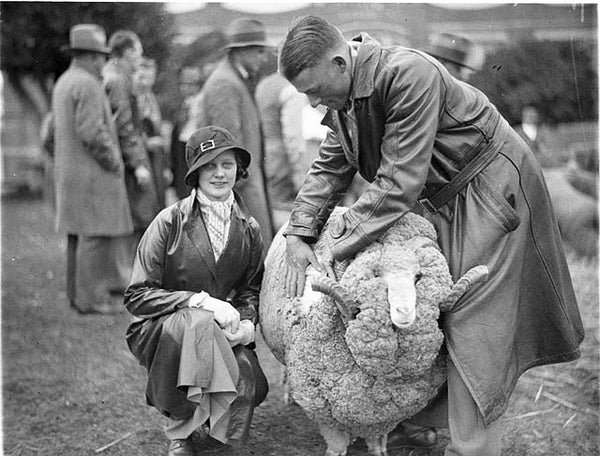Know Your Fiber: Merino Wool
Posted on October 01 2018

Merino sheep are among the most broadly known and popular sheep breeds for wool today. Wool from Merino sheep has gained in popularity over the centuries, and has successfully conquered the fine-wool trade. If you like wool, you have certainly encountered soft, warm and resilient Merino wool at your local yarn shop or clothing store. Curious about where this wool comes from and what its place in history is? Read on!
Sheep were first domesticated in Mesopotamia sometime between 11,000 and 9,000 BCE. Not too long after that, sheep made their way to the African continent, with nomadic sheep herders becoming a fixture of that cultural landscape. One of these nomadic tribes of sheep herders, the Marinids (also known as Benemerines, Meriníes or Banu Marin in Spain) began their rise to power in Morocco during the 1200s. In addition to conquering that part of Northern Africa, they also set their sights on the Iberian Peninsula, successfully occupying a number of cities there for a time, as well as controlling a significant amount of trade that passed through the Strait of Gibraltar.
It was after this initial period of upheaval and during an era of new trade that the first sheep from the North African Marinid flocks were likely introduced to Spain. Historical records about sheep from this time are scarce, but fine-wooled North African sheep are generally believed to have been introduced to Spain sometime between the early 1300s and mid-1400s. Impressed with their wool, it didn’t take long for Spanish shepherds to add these sheep to their own flocks once they became broadly available. After some time, the Spanish herds that were mixed with the North African sheep combined to produce some of the most sought after traits: fine- and dense-wooled sheep. However, it took longer to develop the breed than it would have even a few centuries later – the intensive breeding techniques used by sheep breeders today, or even 200 years ago had not yet been developed. It is likely that this new sheep breed likely took its name from the Marinid dynasty – it takes very little imagination to see how one of the Spanish words for the Marinid dynasty (Meriníes) could easily have morphed into merino.
Although Merino sheep were around during the Middle Ages in Spain, there were initially not enough of them to have a significant impact on the European wool market. Early cross breeds of the Spanish and North African sheep simply were not producing either enough wool or consistently fine wool during this time – it took time for these new genes to work their way through the Spanish flocks. Merino was starting to make a name for itself, but it wasn’t as widely available as the English wool that dominated the wool market throughout much of the Middle Ages. The English flocks were producing an enormous quantity of wool, and their traders controlled a large part of the European wool trade. However, this began to change around the late 1500s.
Spanish shepherds had been busily raising and increasing the numbers of their Merino sheep for much of the Middle Ages, and word was getting out about these wondrous long- and fine-wooled sheep. By the late 1500s, the number of Merino sheep in the Spanish flocks had reached a point that their in-demand wool was upsetting the English grip on the wool trade. Everyone wanted it, and Spain was happy to trade this luxurious and soft wool for sums above and beyond that of average English wool. However, they were not about to trade away their Merino sheep. Spain had successfully cornered the fine wool market, and didn’t want anyone else to share it. To this end, Spain prohibited the export of Merino sheep, on pain of death, all the way through the beginning of the 1700s.
In 1735, the Spanish monarchy allowed the first Merino breeding stock to leave Spain for Germany, which was followed over the next century by gifts of breeding stock to royalty in other European courts. Notably, given the well-known political animus between Spain and England, the English court did not receive any such gifts of Merino sheep. And oh, how everybody wanted them! Merino sheep were in demand more and more as the 1700s progressed – there was almost a mania for them. With the development of newly invented science-based and intensive sheep breeding techniques in England during the late 1700s, many countries and sheep breeders wanted to acquire enough Merino sheep so that they could add Merinos’ dense- and fine-wooled traits to their own flocks. They wanted in on the booming market for fine wool
If you were not select royalty you were pretty much out of luck – there were no legitimate ways for the average sheep farmer to get a prized Merino ram or ewe until about the first decade into the 1800s. However, there were certainly illegitimate ways. Paying someone to smuggle Merino sheep out of Spain offered the chance of a prized ram or ewe. Certainly that is how the U.K. acquired their first Merino sheep (4 rams and 2 ewes), which Sir Robert Banks paid some enterprising business person to smuggle out of Spain via Portugal.
However, more often than not, it appears that the people purchasing Merinos through less than legitimate means during this time frame were either getting scammed or simply provided with any Spanish sheep that smugglers could manage to get out of Spain. Among the many, many people trying to get a Merino through any means necessary was Thomas Jefferson. He was thrilled to be given a Merino ram as a gift from Robert Morris, a financier of the American Revolution. The ram had been smuggled out of Spain by one of the captains of Morris’ ships. However, this prized Merino sheep kept for years by Jefferson (who would apparently boast of it frequently) turned out to be a plain Spanish Churro – one of the most common sheep on the Iberian Peninsula with wool much coarser than that of a Merino. It was not until 1801, during which he was president, that he finally received his first actual Merino from the Du Pont family of Delaware, who emigrated from France.
The first actual Merino sheep arrived in the United States in 1793, and had a brief, if notable, life. They were given as a gift to Andrew Craigie by William Foster. Unaware of their value, he butchered and ate them! History tends assumes that he was chagrined -- he was unable to purchase any more until 16 years later when he had to pay $1000 for a Merino ram.
By 1810, the desire for Merinos in Europe and North American had reached fever pitch, and it turned out that the Peninsular War between Spain and France (and the U.K. and Portugal) was the event finally opened up the Merino sheep market. Looking to avoid the seizure or killing of their Merino sheep by the French, and to continue financing the war, Spain began to sell off their Merino flocks. The United States was among many other countries took immediate advantage of this. Between 1810 and 1811, over 19,000 Merino sheep from Spain arrived in the United States. Once the international market was flooded with so many Merinos, the prices also went down. Merinos that had once sold for $1000 or more were soon being sold for $100-$300, or less.
Once Merino sheep were no longer being controlled by Spain, it became immensely popular to breed them with other sheep to see what improvements adding a bit of Merino to the mix could make. Many breeds of today’s sheep can find a bit of Merino in their ancestry. And Merinos themselves have continued to be improved upon as well –through continued breeding and refining of their best traits over the past 200 years, the Merino sheep of today bear only some resemblance to the earliest Merino sheep.
Although Merino remains a popular breed among farmers in the United States and the rest of the world, it is Australia that is best known today for its quality Merino wool and the enormous quantities it produces. The first Merino sheep arrived in Australia in the early 1800s. However, it was Eliza and her husband John Furlong, originally of Scotland, who are credited with firmly establishing Merinos popularity in that part of the world. In the 1820, Eliza and John Furlong had lost two children to consumption, and decided to move to Australia with their two surviving children in search of a warmer climate that they hoped would prevent a reoccurrence. They settled upon raising sheep as an occupation, but wanted to ensure they had the best possible stock. To this end, Eliza Furlong traveled back to Europe to go to Saxony and Prussia. She explored these regions on foot, selecting by hand the best Saxon Merino sheep she could find to add to her flock. Altogether, she walked 1500 miles to collect her family’s first flock, bringing them to Scotland to be shipped to her husband at her farm in Australia. Then she did the exact same thing two more times to get flocks for each of her sons! Eliza’s extraordinary commitment to finding and raising only the highest quality Merinos, and the lengths to which she went to help her family succeed is legendary among Australian Merino sheep farmers.
Merino is now the most popular wool in the world! Today, Australia produces close to 80% of the world’s Merino wool, followed by South Africa, Uruguay, Argentina and New Zealand. The wool produced by Merinos is very dense – compared to other sheep raised for wool, they can have more than twice the number of wool follicles per square millimeter. This increased amount of wool available from one sheep makes Merinos a very popular sheep among farmers. Among crafters and designers, Merino is renowned for its fineness and elasticity, which can be made into woven, knitted, crocheted or felted wool fabrics that can be very comfortably worn directly against the skin. Merino is graded to a variety of micron widths including Superfine (17.6-18.5 microns), Fine or Extrafine (18.6-19.5 microns), Fine Medium (19.6-20.5 microns) and Medium (20.6-22.5 microns). Unless otherwise specified, you will find that most merino available in commercial clothing and most yarns is in the Fine Medium to Medium range. However, even though the Fine Medium and Medium Merino is the most common, it is by no means coarse! 22.5 microns is still quite fine, and extremely comfortable to wear directly against your skin.
Merino is available as fiber and yarn from a wide variety of producers in a veritable rainbow of colors. Here at Northwest Yarns, we offer several types Merino fiber (including Superfine Merino!) and yarns in our online store, and even more at our brick-and-mortar shop. Stop on by on-site or online and check out the Merino wool that's right for your project!

Follow US